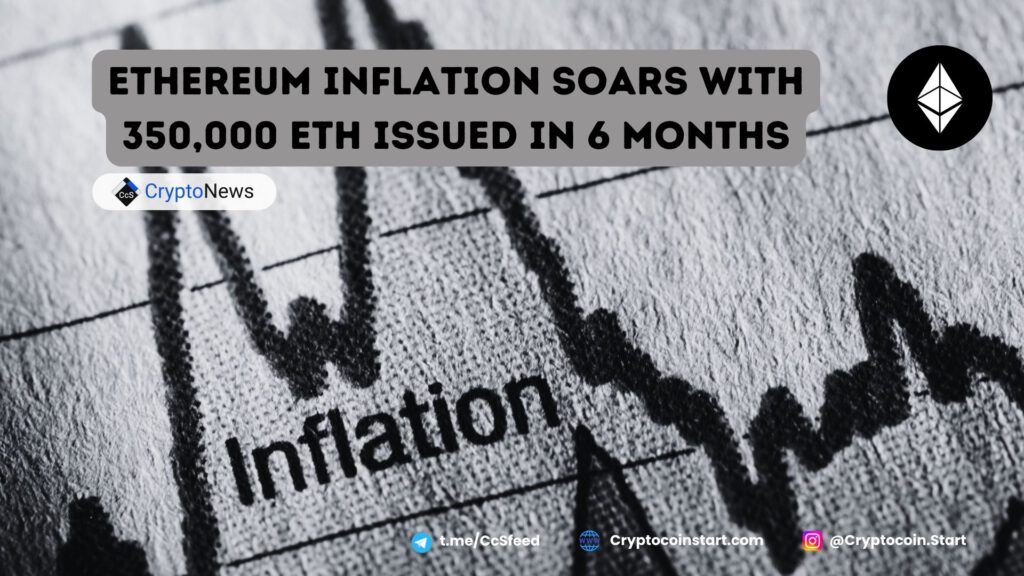
350,000 ETH Issued Since April: Impact on Ethereum’s Inflation
Ethereum has seen a surge in the issuance of new tokens since April, with 350,000 ETH being minted during this period. This increase in supply has sparked discussions within the crypto community about the potential impact on Ethereum’s economic stability and long-term value. In particular, the rise in issued ETH comes at a time when the network has experienced a decline in the ETH burn rate, leading to a higher overall supply of ETH.
Some key points to consider include:
- Increased ETH Issuance – Since April, Ethereum has issued 350,000 ETH, contributing to a rise in the overall circulating supply.
- Decreased ETH Burn Rate – The Ethereum network’s burn rate has slowed since March, leading to a reduction in the number of ETH being destroyed through the EIP-1559 mechanism.
- Inflation Concerns – The combination of increased issuance and a reduced burn rate has raised concerns about potential inflationary pressures on Ethereum, which could impact its value.
This trend marks a stark contrast to the peak of Ethereum’s inflationary activity earlier this year, particularly in March, when ETH burning was at its highest levels. During that time, the deflationary trend was further amplified by Bitcoin’s surge to an all-time high (ATH), creating significant demand for ETH and driving its price higher. However, since April, the decrease in Ethereum’s burn rate has led to an uptick in the total supply, putting inflationary pressure on the network.
Memecoin Craze Sparks Brief ETH Burn Rebound in August
One of the more interesting developments in Ethereum’s burn rate occurred in August, when the memecoin frenzy caused a brief but significant increase in ETH burns. This surge was primarily driven by the high transaction fees associated with memecoin trading, which in turn spiked the Ethereum burn rate. However, this effect was short-lived as the memecoin hype eventually faded, and transaction volumes returned to more normal levels.
The key takeaways from this event include:
- Memecoin Hype Drives ETH Burns – During the height of the memecoin craze, increased transaction activity led to higher ETH burns, briefly boosting scarcity.
- Temporary Effect – The spike in ETH burns was short-lived as the memecoin craze cooled off, highlighting the transient nature of such trends on Ethereum’s burn rate.
- Volatile Burn Rates – The memecoin-induced burn spike highlights how market fads can temporarily influence Ethereum’s economic mechanics, but the overall burn rate remains inconsistent.
While the memecoin-driven burn increase was a short-term boost for Ethereum’s scarcity, the fundamental issue of inflation persists. With the ongoing issuance of new ETH and a lack of consistent burn mechanisms, Ethereum faces the challenge of maintaining value in the face of growing supply.
Ethereum’s Economic Future: Inflationary Pressures and Scarcity
The combination of rising ETH issuance and a reduced burn rate has created a constant inflationary pressure on Ethereum, raising questions about the network’s future value and scarcity. Without substantial counteracting burns to offset the new supply, Ethereum’s inflation could potentially dilute its value over time. This delicate balance between issuance and destruction is critical for Ethereum’s long-term economic health.
Analysts and investors alike are closely monitoring the situation, with some expressing concerns that if Ethereum’s burn rate does not significantly increase, the network could face diminishing scarcity, undermining its value proposition. As Ethereum evolves, the ability to maintain a sustainable burn rate—one that adequately counteracts the growing issuance of new tokens—will be a key factor in determining its future success.
Conclusion: The Delicate Balance of Issuance and Destruction
Ethereum’s inflationary pressures, driven by the issuance of 350,000 ETH since April and a declining burn rate, present a challenge for the network’s economic sustainability. While short-term events like the memecoin hype have provided temporary boosts to ETH burns, the long-term health of Ethereum will depend on finding a sustainable balance between issuance and destruction. If Ethereum cannot maintain sufficient scarcity through ongoing burns, the value of ETH could be at risk as the network continues to issue new tokens. Investors and market participants should closely watch the evolution of Ethereum’s burn mechanisms and overall economic strategy to assess its long-term potential.

